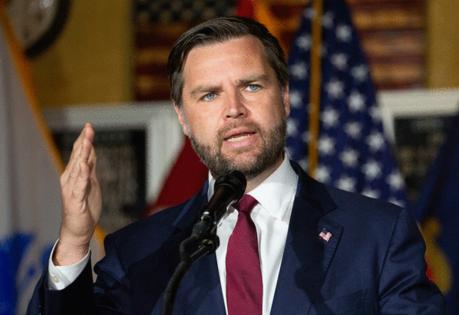On campaign trail, Vance lays out 'concept of a plan' for health care
Published in Health & Fitness
WASHINGTON — Republican vice presidential nominee JD Vance’s plan to rework President Barack Obama’s signature health care law is vague on details, but many conservative health care experts say it would take the Republican Party back to a place it doesn’t want to go.
Vance’s comments, made over the last week, have added some details to Republican presidential nominee Donald Trump’s assertion during the Sept. 10 presidential debate that he had a “concept of a plan” to reform the Obama-era health exchanges.
“We’re going to actually implement some regulatory reform in the health care system that allows people to choose a health care plan that works for them,” Vance said at a campaign rally last week in Raleigh, N.C., adding that people who use the health care system frequently would be on a different plan from those who are healthy and don’t go to the doctor as often.
“Now, what that will also do is allow people with similar health situations to be in the same risk pools,” the Ohio senator added.
Republican health policy experts say Vance’s comments could allude to one of several policy changes: restructuring insurance risk pools, expanding the transitional reinsurance programs or reinstating Trump-era changes to short-term limited duration plans.
Or it’s possible he’s just improvising.
“I’m not sure he knows what he means,” said Chris Pope, senior fellow at the Manhattan Institute, a conservative-leaning think tank. But, Pope conceded, politicians don’t often go into extreme policy detail on the campaign trail.
Sen. Bill Cassidy, R-La., the ranking Republican on the Senate Health, Education, Labor and Pensions Committee, was very involved in the repeal and replace effort in 2017, and said he’d need to see more details on Vance’s plan before making a judgment.
But he suggested going back to risk pools could be challenging.
“The actuarial case would be difficult,” Cassidy said of separating the sick and healthy into different insurance risk pools.
“Historically there have been some adverse selection issues,” he added.
The Trump-Vance campaign did not return a request for comment.
The focus on health care policy, specifically changes to the 2010 health law, is unusual for this 2024 campaign. In April Trump emphasized he was not interested in changing or overturning the law.
That statement marked a shift from Trump’s presidency, when he fought to deregulate or even overturn the law. After several failed attempts to do so, Trump — and the Republican Party — moved on.
But this election cycle it’s Vance, not Trump, taking the lead on policy on the campaign trail. Vance was not a member of Congress during the Trump administration, when Republicans spent considerable effort trying to repeal and replace the health care law.
Policy experts who support changes to the health care law are skeptical that overhauling the law would be a priority or even tenable for a Trump-Vance administration.
“Do I think this is something that Trump and Vance care about or will push themselves?” said Michael Cannon, director of health policy studies at the libertarian Cato Institute. “I’m not holding my breath.”
Risk pools
Vance first pitched changes to health insurance risk pools during a Sept. 15 appearance on “Meet the Press.”
“Think about it: A young American doesn’t have the same health care needs as a 65-year-old American. A 65-year-old American in good health has much different health care needs than a 65-year-old American with a chronic condition,” said Vance, while critiquing the “one-size-fits-all approach that puts a lot of people into the same insurance pools.”
High-risk pools, which spread out health care costs only among those with certain preexisting conditions, have mostly become obsolete after the implementation of the 2010 health care law, which required that insurers cover people with preexisting conditions the same as healthy individuals. As a result, everyone’s in one risk pool, and everyone pays the same insurance premiums regardless of their health status.
The required coverage of high-risk pools quickly became one of the most popular parts of Obama’s health care law.
But some Republicans have held on to the idea of separating out risk in the insurance markets, despite the widespread popularity of covering individuals with preexisting conditions. Proponents of using both high- and low-risk pools argue that this method can allow insurers to provide cheaper plans for individuals with fewer expected needs.
“The preexisting conditions provisions in Obamacare are undermining universality,” said Cannon.
Cannon argues that preventing insurers from discriminating against people with preexisting conditions at enrollment doesn’t change the economic reality of covering those more expensive conditions.
“You’ve only made it impossible for insurers to be transparent about how they deal with them, and so they will deal with them in less transparent and more harmful ways,” he said, pointing to the exchanges.
Republicans tried to change the risk pools in 2017. Trump and then-House Speaker Paul D. Ryan, R-Wis., promoted a $15 billion federal high-risk pool to provide insurance coverage for Americans with preexisting conditions in an effort to lower costs for healthy people. The legislation failed in the Senate with Arizona Republican Sen. John McCain’s infamous thumbs-down vote.
It’s possible Vance’s plan may not involve two separate risk pools on the exchanges, Pope hypothesized.
Instead, those who are currently on the health care exchange who like their plans could remain on their plans and continue to have all the protections of the law, including coverage for preexisting conditions along with the 10 essential health care benefits, which include preventive care, laboratory services and mental health.
But healthy individuals who do not need coverage for preexisting conditions and who may want to pay less could opt out into another government-sponsored insurance plan that would cost less, Pope explained.
Still, most Republican policy experts say that this is not a smart policy and could lead to more federal spending, a greater deficit and increased government involvement in the health care markets.
“From a rational standpoint, this doesn’t make any sense,” Joe Antos, senior fellow emeritus at the conservative American Enterprise Institute, said.
“You can’t do it that way. You need some healthy people in there with some sick people. Otherwise you’re going to have a financially unsustainable system,” Antos added.
Reinsurance
Ed Haislmaier, senior research fellow at the Center for Health and Welfare Policy at the Heritage Foundation, said campaign remarks tend to be high-level and conceptual, compared with the nitty-gritty of actual regulations and legislation.
“The problem here is people are reading into a general observation details that may not be there,” he said.
But the general proposal, as he interprets it, is more likely to refer to a back-end restructuring of risk pools among insurers.
“In other words, it would all be the same to the enrollees. They wouldn’t see a difference,” said Haislmaier. “What you’re doing is you’re moving the dollars around.”
Haislmaier said if it is this policy, it’s something that has been successful under both Republican and Democratic administrations and could work more broadly.
For example, states can currently apply for Section 1332 state innovation reinsurance waivers that allow marketplace subsidies to be paid directly to the state to reallocate rather than straight to the insurer.
“It’s worked to bring down premiums in states, and this has been in red states and blue states as well,” he said, adding that it could also be a discussion for the next Congress on how to streamline the expansion of this process.
Other options
Republicans on Capitol Hill have been pushing for other changes to lower costs on the federal health care exchanges that don’t involve separating the risk pools, such as codifying the Trump rule on short-term plans or expanding association health plans.
The Trump administration expanded short-term health plans to 12 months. The plans were traditionally meant to be a low-cost, skimpier coverage option for people in times of transitional coverage. The Biden administration reversed this rule because many Americans were purchasing the cheaper plans without realizing they had few consumer protections, and once again limited the plans to four months.
Republicans on Capitol Hill criticized the move. Cassidy and Mike Braun, R-Ind., said the move forced “individuals and families into plans that are more expensive and less tailored to their needs.”
House Republicans are also in favor of expanding association health plans, which are offered by groups of employers that join forces and are not required to meet the 2010 health care law’s parameters.
The Trump administration’s 2018 rule was vacated by a federal judge in 2019 before it could go into effect, though the Trump administration tried to appeal that ruling. The Biden administration proposed to rescind the 2018 rule.
Earlier this month, Republicans on the House Education and the Workforce Committee voted in support of a Congressional Review Act resolution to block the Biden administration’s rule limiting access to association health plans. Republicans argued that the plans help small businesses lower health costs for their employees.
A messaging problem
Right-leaning policy experts largely agree that the Trump-Vance campaign is facing a messaging problem on health insurance policy. Lowering costs is popular. Relitigating the 2010 health care law is not.
Antos encouraged the Trump-Vance campaign to take a page out of Democratic presidential nominee Kamala Harris’ campaign playbook and speak in more broad terms about the health costs while talking to voters. Republicans spent years trying to repeal and replace the 2010 health care law and failed to do so. Voters, they say, have largely moved on and lost interest.
“Health insurance clearly is not a very relevant issue for the election,” Antos said. “I’m not saying that the insurance problems have been solved. It’s just that they’ve been truly minimized. Basically, the ACA [the 2010 health care law] did work.”
©2024 CQ-Roll Call, Inc., All Rights Reserved. Visit cqrollcall.com. Distributed by Tribune Content Agency, LLC.










Comments